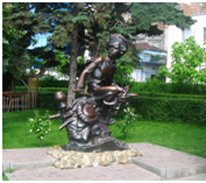Rostov-on-Don is a main industrial, scientific and culture center on South of Russia, administrative center of Southern Federal District with population of more than 1 300 million people. It is the 10th biggest city in Russia. Together with Rostov agglomeration population of the city is 1.8 million people (6th place in the country).
Rostov is about 1050 km from Moscow, 530 km from Sochi, 400 km from Black Sea, 50 km from Azov Sea.
Climate in the city is moderate. Winters are generally mild (average temperature in January is −5 °C), summers are continuous, hot and sunny (average temperature in July is +29 °C).
Officially city was founded in December 1749 when a custom-house was set up on the hilly river of Temernik (a tributary of the river Don) to control the trade with Turkey according to the edict of the Empress Elizabeth, the daughter of Peter the Great. Not far from the custom house grew the fortress which was named after Russian metropolitan, Saint Dimitry of Rostov, a newly-glorified bishop from the old Northern town Rostov the Great. Later the name was changed to Rostov (in 1806) and then to Rostov-on-Don.
Today the City Day is celebrated on the third Sunday of September. Due to its good geographical position on the crossroads of the land and water roads, Rostov was developing rapidly. In the middle of 19th century only 15 thousand people lived in the town, fifty years later the population grew up to 110 thousand people. Base of the Rostov economics was trade, it was even called a «merchant’s city». Commercial port that was organized near the city accepted Russian, Greek, Italian, Turkish, Persian, and Armenian traders.
By the of the XX century Rostov had more than 100 establishments including the largest ones and country famous plant «Aksai», Major Workshops of the Vladicaucasus Railroad, shipbuilding and two tobacco factories. It is important that every third factory belonged to the foreign capital.
After the Socialist Revolution in 1917, Rostov was developing together with the whole country. By the end of the 30-ies it was one of the largest cities of Soviet Union in population and in the level of economiс development.
Today, being a big city Rostov is littered with landmarks that create a city that is not only interesting but eclectic and memorable.
City boasts country-famous Theatre of Drama which model is exhibited in London Museum of History and Architecture; all-year round Farmers’Central Market which is home to more than 800 year-round commercial businesses and farmers; The Left Bank of the River Don – the longest street totally covered with restaurants and cafes with unique and delicious Russian and international cuisine. Besides it Rostov has a lot of museums, theatres, cinemas, parks, sport facilities, cafes, restaurants, night clubs and mega-malls.
Source: Official Portal of Rostov-on-Don Municipal Duma and City Administration.



